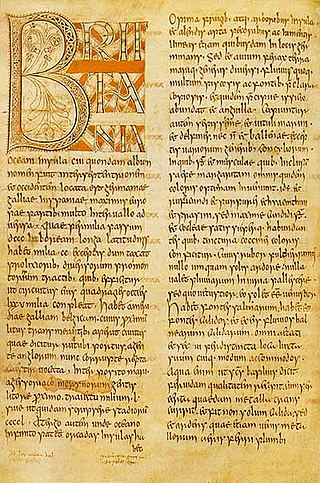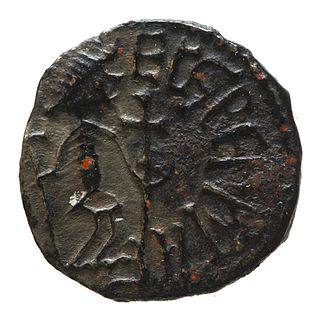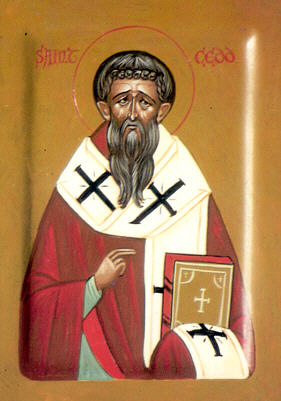Life
Ecgberht was an Anglo-Saxon of a noble family, probably from Northumbria. [1] After some years of study in the monastery of Lindisfarne, he travelled to Ireland to study. [2] One of his acquaintances at this time was Chad of Mercia. [3] He settled at the monastery of Rath Melsigi, in modern-day county Carlow. [4] In 664, most of his Northumbrian travelling companions, including Æthelhun, died of the plague, and he contracted it as well.
Ecgberht vowed that if he recovered, he would become a "peregrinus" on perpetual pilgrimage from his homeland of Britain and would lead a life of penitential prayer and fasting. [1] He was twenty-five, and when he recovered he kept his vow until his death at age 90. [4] According to Henry Mayr-Harting, Ecgberht was one of the most famous ‘pilgrims’ of the early Middle Ages, [1] and occupied a prominent position in a political and religious culture that spanned northern Britain and the Irish Sea. [5]
Ecgberht was ordained a priest and began to organize monks in Ireland to proselytize in Frisia; [6] many other high-born notables were associated with his work: Adalbert, Swithbert, and Chad. He, however, was dissuaded from accompanying them himself by a vision related to him by a monk who had been a disciple of Boisil (the Prior of Melrose under Abbot Eata). [6] Ecgberht instead dispatched Wihtberht, another Englishman living at Rath Melsigi, to Frisia. [5] Ecgberht then arranged the mission of Wigbert, Willibrord, and others. [7]
In 684, he tried to dissuade King Ecgfrith of Northumbria from sending an expedition to Ireland under his general Berht, but he was unsuccessful. [8]
While in Ireland, Ecgberht was one of those present at the Synod of Birr in 697, when the Cáin Adomnáin was guaranteed. [9]
Ecgberht had influential contacts with the kings of Northumbria and of the Picts, as well as with Iona, to which he moved around 716. He attempted to persuade the monks there to adopt the Roman Easter dating. [10] He died on Iona [11] at the age of ninety, on the first day that the Easter feast was observed in this manner in the monastery, on 24 April 729. [12]
His feast day in the Roman Catholic Church, 24 April, is found in both the Roman and Irish martyrologies, and in the Metrical Calendar of York. Although he is now honoured simply as a confessor, it is probable that Ecgberht was a bishop. [13]
Ecgberht ought not to be confused with the later Ecgberht, Archbishop of York, or Egbert of Lindisfarne.

Bretwalda is an Old English word. The first record comes from the late 9th-century Anglo-Saxon Chronicle. It is given to some of the rulers of Anglo-Saxon kingdoms from the 5th century onwards who had achieved overlordship of some or all of the other Anglo-Saxon kingdoms. It is unclear whether the word dates back to the 5th century and was used by the kings themselves or whether it is a later, 9th-century, invention. The term bretwalda also appears in a 10th-century charter of Æthelstan. The literal meaning of the word is disputed and may translate to either 'wide-ruler' or 'Britain-ruler'.

Northumbria was an early medieval Anglo-Saxon kingdom in what is now Northern England and south-east Scotland.
The Synod of Whitby was a Christian administrative gathering held in Northumbria in 664, wherein King Oswiu ruled that his kingdom would calculate Easter and observe the monastic tonsure according to the customs of Rome rather than the customs practiced by Irish monks at Iona and its satellite institutions. The synod was summoned at Hilda's double monastery of Streonshalh (Streanæshalch), later called Whitby Abbey.
Wilfrid was an English bishop and saint. Born a Northumbrian noble, he entered religious life as a teenager and studied at Lindisfarne, at Canterbury, in Francia, and at Rome; he returned to Northumbria in about 660, and became the abbot of a newly founded monastery at Ripon. In 664 Wilfrid acted as spokesman for the Roman position at the Synod of Whitby, and became famous for his speech advocating that the Roman method for calculating the date of Easter should be adopted. His success prompted the king's son, Alhfrith, to appoint him Bishop of Northumbria. Wilfrid chose to be consecrated in Gaul because of the lack of what he considered to be validly consecrated bishops in England at that time. During Wilfrid's absence Alhfrith seems to have led an unsuccessful revolt against his father, Oswiu, leaving a question mark over Wilfrid's appointment as bishop. Before Wilfrid's return Oswiu had appointed Ceadda in his place, resulting in Wilfrid's retirement to Ripon for a few years following his arrival back in Northumbria.
Ecgfrith was the King of Deira from 664 until 670, and then King of Northumbria from 670 until his death in 685. He ruled over Northumbria when it was at the height of its power, but his reign ended with a disastrous defeat at the Battle of Nechtansmere against the Picts of Fortriu in which he lost his life.

Willibrord was an Anglo-Saxon missionary and saint, known as the "Apostle to the Frisians" in the modern Netherlands. He became the first Bishop of Utrecht and died at Echternach, Luxembourg.

The Ecclesiastical History of the English People, written by Bede in about AD 731, is a history of the Christian Churches in England, and of England generally; its main focus is on the conflict between the pre-Schism Roman Rite and Celtic Christianity. It was composed in Latin, and is believed to have been completed in 731 when Bede was approximately 59 years old. It is considered one of the most important original references on Anglo-Saxon history, and has played a key role in the development of an English national identity.

Wigbert, (Wihtberht) born in Wessex around 675, was an Anglo-Saxon Benedictine monk and a missionary and disciple of Boniface who travelled with the latter in Frisia and northern and central Germany to convert the local tribes to Christianity. His feast day is August 13.

Ecgbert was an 8th-century cleric who established the archdiocese of York in 735. In 737, Ecgbert's brother became king of Northumbria and the two siblings worked together on ecclesiastical issues. Ecgbert was a correspondent of Bede and Boniface and the author of a legal code for his clergy. Other works have been ascribed to him, although the attribution is doubted by modern scholars.

Adalbert of Egmond was a Northumbrian Anglo-Saxon missionary. He was one of Willibrord's companions in preaching the gospel in Holland and Frisia.

Anglo-Saxon missionaries were instrumental in the spread of Christianity in the Frankish Empire during the 8th century, continuing the work of Hiberno-Scottish missionaries which had been spreading Celtic Christianity across the Frankish Empire as well as in Scotland and Anglo-Saxon England itself during the 6th century. Both Ecgberht of Ripon and Ecgbert of York were instrumental in the Anglo-Saxon mission. The first organized the early missionary efforts of Wihtberht, Willibrord, and others; while many of the later missioners made their early studies at York.

Cedd was an Anglo-Saxon monk and bishop from the Kingdom of Northumbria. He was an evangelist of the Middle Angles and East Saxons in England and a significant participant in the Synod of Whitby, a meeting which resolved important differences within the Church in England. He is venerated in the Catholic Church, Anglicanism, and the Orthodox Church.
Saint Ceolwulf was King of Northumbria from 729 until 737, except for a short period in 731 or 732 when he was deposed and quickly restored to power. Ceolwulf abdicated and entered the monastery at Lindisfarne. He was the "most glorious king" to whom Bede dedicated his Historia ecclesiastica gentis Anglorum.

In the seventh century the pagan Anglo-Saxons were converted to Christianity mainly by missionaries sent from Rome. Irish missionaries from Iona, who were proponents of Celtic Christianity, were influential in the conversion of Northumbria, but after the Synod of Whitby in 664, the Anglo-Saxon church gave its allegiance to the Pope.

Saint Suitbert, Suidbert, Suitbertus, Swithbert, or Swidbert was born in Northumbria, England, in the seventh century, and accompanied Willibrord on the Anglo-Saxon mission.

Boisil was a monk of Melrose Abbey, an offshoot of Lindisfarne, then in the Anglo-Saxon Kingdom of Northumbria, but now in Scotland, where he must have been one of the first generation of monks. He probably moved to the new foundation of Melrose when it was started, some time in the late 640s.
Rath Melsigi was an Anglo-Saxon monastery in Ireland. A number of monks who studied there were active in the Anglo-Saxon mission on the continent. The monastery also developed a style of script that may have influenced the writers of the Book of Durrow.
Hartlepool Abbey, also known as Heretu Abbey, Hereteu Abbey, Heorthu Abbey or Herutey Abbey, was a Northumbrian monastery founded in 640 CE by Hieu, the first of the saintly recluses of Northumbria, and Aidan of Lindisfarne, on the Headland Estate of Hartlepool now called the Heugh or Old Hartlepool, in County Durham, England.
Dryhthelm, also known as Drithelm or Drythelm, was a monk associated with the monastery of Melrose known from the Historia Ecclesiastica gentis Anglorum of Bede. According to the latter, before entering the religious life he lived with his family in "a district of Northumbria which is called Incuneningum". Incuneningum is thought by some modern scholars to refer to Cunninghame, now part of Ayrshire.
Hieu was a 7th-century Irish abbess who worked in Northumbria. She was foundress of abbeys at Hartlepool and Healaugh in Yorkshire England. Hieu was also the first of the saintly recluses of Northumbria, and the first known woman to rule a double monastery.
 This article incorporates text from this source, which is in the public domain .
This article incorporates text from this source, which is in the public domain .










